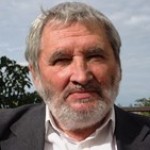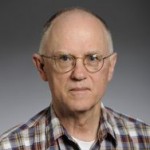Home › Forums › 2015 International Workshop on Quantum Foundations › Nonlocality and relativity › The Locality of the Modified Quantum Mechanics
- This topic has 6 replies, 3 voices, and was last updated 8 years, 9 months ago by
 Robert Griffiths.
Robert Griffiths.
-
AuthorPosts
-
June 24, 2015 at 7:33 pm #2387
 Jiri SoucekParticipant
Jiri SoucekParticipantThe derivation of Bell inequalities (BI) has created the inconsistency in the
Quantum Theory (= Quantum Mechanics + Relativity).
BI disagree with quantum mechanics (QM) and also with the results of experiments. BI assert that something in the theory is not in order. The theory is wrong since it was possible to derive BI (the derivation
uses assumptions of locality and realism).
Thus the basic problem is to ensure the non-derivability of BI. But this needs deep changes in QM. There are two possibilities
(i) The nonlocality of QM.
(ii) The non-realism of QM. This possibility was discussed only in general
terms, but the explicit formulation of the non-realistic variant of QM was never presented (at least as we are informed).
The only concrete proposal of the non-realism was the modified QM (modQM)
presented here.
The purpose of this paper is to give the clear formulation of modQM using the
axiomatic formulation.
The other purpose is to show the functioning of the measurement process in
modQM, since this process does not make a part of axioms. The measurement
process is in modQM replaced by the concept of an observation.
The next goal is to describe the relation between modQM and the standard
QM (stQM).
These two theories are fundamentally different, but they have the
same experimental consequences. The difference between these theories can be
simply seen from the following implications
locality + stQM do imply BI,
locality + modQM do not imply BI.
This allows the locality of modQM.July 8, 2015 at 1:58 am #2520 Robert GriffithsParticipant
Robert GriffithsParticipantDear Jiri,
Three comments.
First, I disagree with your assertion that it is possible to derive Bell inequalities in the framework of quantum mechanics. This claim is widespread, but it ignores a key assumption made by Bell and his followers: the existence of classical hidden variables not described by the quantum Hilbert space. Once one insists that quantum mechanics employ Hilbert subspaces to represent properties the whole Bell argument falls apart. A detailed proof is in my article “Quantum Locality,” Found. Phys. 41 (2011) 705; arXiv:0908.2914, in which I demonstrate that a version of Einstein locality is fully consistent with quantum principles. No one has yet refuted the argument in that paper, which of course may mean that no one has read it, apart from the referee (David Mermin) who tried his best to poke a hole in it without success. For a gentler introduction see my “EPR, Bell, and Quantum Locality”, Am. J. Phys. 79 (2011) 954. arXiv:1007.4281.
Second. I am perplexed by your desire for a non-realist version of quantum mechanics. We physicists have become pretty well convinced, after a century of hard thought and careful experiments, that the reality which we probe with our experiments is quantum mechanical. Do you think that something has to follow the laws of classical physics to be “real”?
Third. What do you think you have gained by replacing ‘measurement’ by ‘observation’? This looks very much like the von Neumann chain, which many of us working in quantum foundations do not find very satisfactory.
Bob Griffiths
July 8, 2015 at 8:58 am #2525 Miroljub DugicParticipant
Miroljub DugicParticipantDear Robert [if i may?]
following “In particular, Equality means that from the point of view of fundamental quantum mechanics there is no reason to prefer one consistent family to another, there is no law of nature that singles out ‘the right family‘.”–from your Am. J. Phys. 79 (2011) 954. arXiv:1007.4281–i have the following question:
If Equality allows for arbitrary tensor-product-structure (TPS) to be chosen, whether consistency of histories for one TPS may be in some conflict with the consistency for another TPS of the total (closed) system? If so, which TPS should be chosen?
Best regards,
Miroljub
July 9, 2015 at 2:09 am #2547 Robert GriffithsParticipant
Robert GriffithsParticipantDear Miroljub,
There are certainly many situations in which the data you have or are considering can be placed in or represented by different consistent families which are mutually incompatible, and this is one of the standard objections to consistent histories. My response is that there is no “right” family; this is something I take up under the heading of ‘unicity’ in Sec. 27.3 of Ch. 27 of my book [http://quantum.phys.cmu.edu/CQT/]. On the other hand, for particular instances, as when one is concerned with how measurement outcomes reflect the properties the device was built to measure, it turns out that the choice is essentially unique; though making this precise requires something of a technical discussion, as found in Ch. 16 of my book. Or take a look at the discussion of the ‘second measurement problem’ in arXiv:1501.04813.
I hope these comments are of some help.
Best wishes! Bob Griffiths
July 9, 2015 at 11:09 am #2556 Miroljub DugicParticipant
Miroljub DugicParticipantDear Robert,
many thanks for instructions. Before I deleve into full details, please let me emphasize my point again, while having your Am. J. Phys. 79 (2011) 954. arXiv:1007.4281 in mind.
Any set of consistent histories as per eq. (16) may not be consistent for some alternative TPS. For the sake of illustration, let me refer to the hydrogen atom’s structures: ‘electron+proton (e+p)’ and ‘center-of-mass+relative (internal, CM+R)’. Now, considering eq.(16) for the e+p structure does not define a history for the CM+R structure, and vice versa. This simple mathematical fact originating from Entanglement Relativity is my true concern, which does not reduce to the choice of the set of consistent histories you’re mentioning above*. Rather, once made a choice for the e+p excludes the possibility of making a choice for the CM+R atomic structure.
*As long as the TPSs are not regarded [e.g. in eq.(4)] or the TPS is fixed [as assumed in your answer to my previous question], my objection is irrelevant.
Looking forward for further instructions,
Best regards,
Miroljub
July 10, 2015 at 9:50 pm #2617 Jiri SoucekParticipant
Jiri SoucekParticipantDear Robert
thank You for Your mail
your comments were very inspiring for me
to the locality: I agree with You that QM must be local – in the sense that locality must be among axioms. Then possible derivation of Bell inequalities (BI) gives the inconsistency of QM. Thus for me the problém is how to make local QM consistent. I have red your paper, but I was not able to understand the argumentation – Your interpretation seems to me to be too complicated. For me the most difficult problem in local QM is the local explanation of EPR correlations – how the result of Alice` measurement can be transported immediately to Bob – one possibility is the pre-determination of individual results, but this means the hidden parameters and then BI. In standard QM this is the nonlocality of the Collapse rule. I have proposed the possible solution (in http://www.nusl.cz/ntk/nusl-177617) – perhaps You have found the another way how to obtain the local explanation of EPR. In each case I think that to obtain the local QM one must modify standard QM.
to the non-realism: the point is in the concept of the individual state. Following von Neumann, each pure state is individual state (“ensemble in the pure state is homogeneous”). I called this the von Neumann axiom and I think that it is the hidden assumption in standard QM and that it is the main error in QM which must be rejected and substituted by the anti von Neumann axiom: two different individual states must be orthogonal. This then gives the starting point of the modified QM. The main point is the following: the individual state of the measuring system does not imply the individual state of the measured system. There is a fine interplay between collective properties (of ensembles) and individual properties (of individual systems). I have shown that both standard QM and modified QM have the same experimental consequences (quantum predictions are only probabilistic and related to ensembles) – thus the choice between realism and non-realism cannot be experimantally resolved. In modified QM there is nothing classical, only the set of individual states is the small subset of the set of pure states.
to the observation: this concept can be introduced in the non-realistic QM, but not in standard realistic QM. This made possible to solve the measurement problém. I have introduced also the intermediate vetrsion of “minimally non realistic QM” (“http://vixra.org/pdf/1504.0117v1.pdf”), where only anti von Neumann axiom is introduced without the introduction of the concept of the observation. The concept of the observation serves exactly for the task to cut the von Neumann chain.
In general I believe that QM is the probabilistic theory and in each probabilistic theory the state means the probabilistic distribution (the density operator in QM) and the probabilistic distribution is associated with ensemble but not with the individual system. I agree also with You that the evolution of the individual state is stochastic, but the evolution of the probability distribution is smooth.
Your Jiri Soucek
July 12, 2015 at 3:52 pm #2663 Robert GriffithsParticipant
Robert GriffithsParticipantRegarding my exchange with Miroljub, see #2525, #2547, #2556. We have had some exchanges by email and now agree that choosing a decomposition of the identity for use in a family of histories, and choosing a tensor product structure, as when discussing a hydrogen atom, are separate issues, and one choice does not necessarily affect the other.
Bob Griffiths
-
AuthorPosts
- You must be logged in to reply to this topic.

Comments are closed, but trackbacks and pingbacks are open.